The 40. cal vs 45. caliber bullets are by no means as close as the may look on paper and if you’re feeling confident enough with the 40. caliber and want something with a bit more of a kick then it’s best that you fully arm yourself with the details of each before you step up to a .45 caliber bullet.
Unpack This Article's Arsenal
Get Great Guns And Ammo Deals!
SAFEST NEWSLETTER - WE WILL NEVER SELL YOUR EMAIL
No Spam - No Selling Your Email
First a Bit of History – 40 cal vs 45 cal
.40 Cal – Designed in 1990 by S&W (Smith & Wesson), the .40 Cal bullet was made in response to the FBI wanting a replacement for their .38 Cal handguns. They wanted something that would give them more ammunition capacity, greater reliability, was easier to reload and had less velocity. And so the .40 Cal was developed and is now used by all agents in the field.
.45 Cal – Because the underperformance of double action revolvers such as the .303 British and .38 Long Colt in the wars of the early 20th Century, both the American Army and Cavalry requested the harder hitting .45 Cal. The first model came out in 1905 and was later modified to produce the .45 ACP cartridge.
Types of 40 cal and 45 cal Bullets
Though the measurements and ‘stopping power’ of each bullet may differ they do use the same type of bullet: Full Metal Jacketed and Jacketed Hollow Point.
Full Metal Jacketed (FMJ)
Made in lead, the projectiles in these come encased in a copper jacket. An FMJ bullet penetrates well but doesn’t provide expansion on impact. This is noteworthy as it may continue through the target and hit other bystanders and subsequently, most regard these as a great purchase for target practice.
Jacketed Hollow Points
In opposition to FMJ’s, Jacketed Hollow Point bullets do offer expansion on impact creating a larger amount of damage and reducing the chance of peripheral damage by slowing the bullet down due to the jacketed copper cartridge. If your decision to buy guns for self-defense, then it is highly recommended that you get this type of bullet.
Caliber – 40 cal vs 45 cal
The most obvious difference between these two is the caliber and it’s worth knowing a couple of things about it.
What is Bullet Caliber?
The caliber or calibre of a bullet is the diameter of the entire unit or cartridge as it is more commonly known. For example, a .45 caliber bullet has a diameter of .45 inches and can be referred to as a “.45” or “.45 Cal”. This can also be expressed through the metric scale. A .45 Cal bullet is 11.43 mm. When using the metric scale it is common for the length to be expressed too e.g. 9mm x 19mm means that the bullet has a diameter of 9mm and a length of 19mm
When testing bullets and compiling ballistic reports on them, other measurements are taken into consideration. They are:
- Grain (gr) – Weight of the bullet. 7000gr = 1lb
- Velocity (ft/s) – Speed of the bullet in feet per second (ft/s).
- Energy (J) – Potential destructive force of the bullet, measured in Joules.
- Foot-Pound Force (ft-lbf) – Another measurement of Energy.
What is the Grain of a Bullet?
The grain is what gives a bullet its punch and because the laws of physics demand the higher the weight of an object, the more powerful the impact is; the higher the grain of a bullet, the more damage you will inevitably cause. This effect is commonly referred to as a bullets’ “stopping power“.
A .40 Cal bullet has grains of between 115 and 175, whereas a .45 Cal bullet has between 185 and 255 so it’s not difficult to see that .45 Cal is going to have considerably more stopping power and give you more bang for your buck.
What is Bullet Velocity?
Velocity refers to the speed of the bullet in feet per second (ft/s) when it leaves the barrel. Interestingly for all the extra power that the .45 has, it’s actual velocity is less than it’s .40 Cal counterpoint.
When it comes to the energy of the bullets though, the .45 Cal easily out guns (sorry for the pun) the .40 Cal with 50 more joules and 200 ft-lbf.
For a clearer ballistic comparison of the two check out this table below or go here for more ballistic information on other caliber bullets.
Additional Factors In 40 cal vs 45 cal Comparison
The ballistics report is only one side of the story though and other factors do come in to play when comparing the two bullets. Here are the ones we think you should be most aware of.
Accuracy
A lot of the accuracy comes down to quite a number of factors such as the gun used, wind velocity at various distances, barrel size and yes, even the competence of the shooter themselves. Some people can’t hit a barn door with a truck tire.
Both are excellent at short range, however, even if you’re a crack shot, the velocity of the bullet will affect its accuracy over longer distances. The .45 Cal has a lower velocity and therefore more focus must be placed on trajectory when shooting the ammo.
Recoil
The recoil of a firearm should never be ignored and although the .45 Cal has greater penetration, the recoil is less than that of a .40 Cal.
Obviously, this is subjective to the shooter but to give you an idea of the difference, .40 Cal has been described as “sharp” and with a real snap which makes it slower to re-aim for follow up shots than the .45 Cal.
That said, the .45 Cal is known to push shooter’s hands back instead of up and doesn’t have a lot of muzzle flip.
Cost
The price of these bullets may vary depending on where you buy them but as a rule of thumb, the .45 Cal is generally 20% – 60% dearer than the .40 Cal.
40 cal vs 45 cal Ammo Price
For more details on each of the bestsellers on this page check out this page. Bare in mind that these are just suggestions and other lesser known brands will work just as competently. Click on links below to check pricing and buy online.
.40 Cal
| Product Name | Where to Buy | |
|---|---|---|
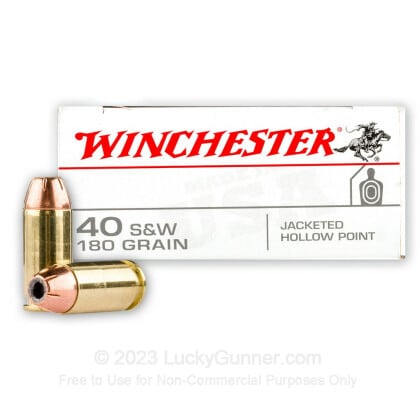 | Winchester 180gr | |
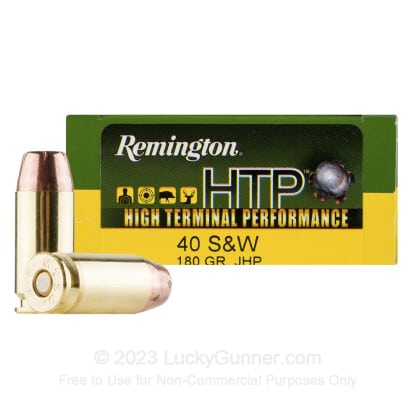 | Remmington 180gr | |
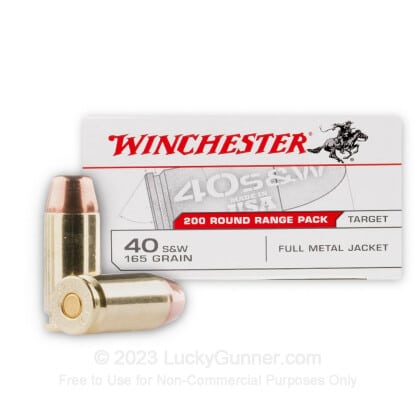 | Winchester 165gr PDX-1 Defender | |
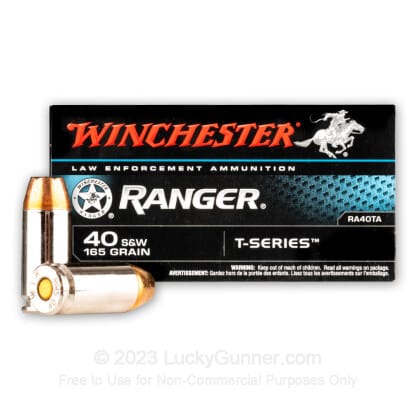 | Winchester 165gr Ranger |
.45 Cal
| Product Name | Where to Buy | |
|---|---|---|
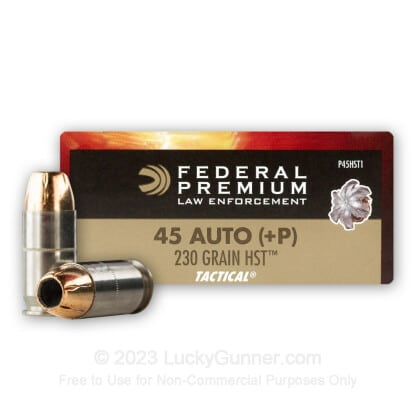 | Federal 230gr HST | |
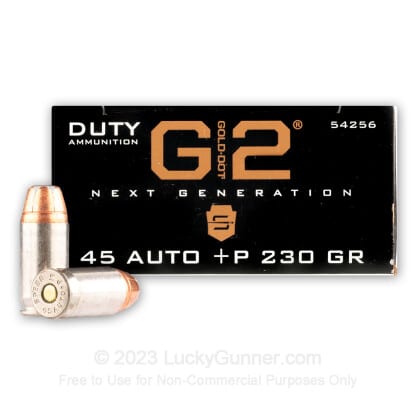 | Speer 230gr Gold Dot | |
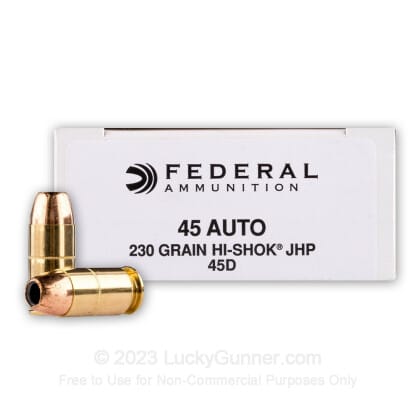 | Federal 230gr Personal Defense | |
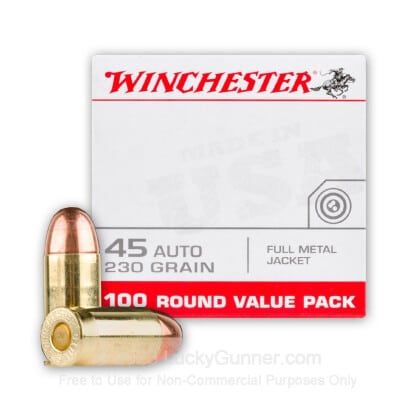 | Winchester 230gr Ranger T-Series | |
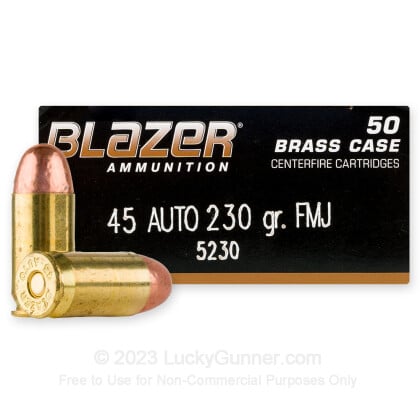 | Blazer Brass 230gr FMJ | |
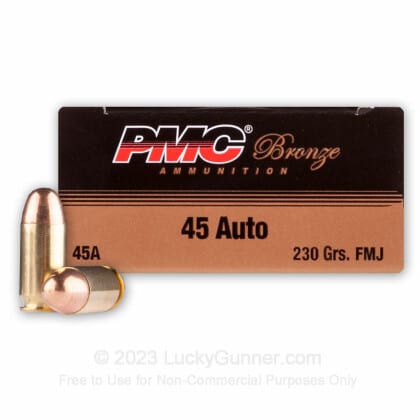 | PMC 230gr FMJ |
All these types have their own idiosyncrasies and you should be sure to test them out at a firing range before making any final decisions. Finding the right match for your handgun is essential.
40 cal vs 45 cal – Conclusion
You should now have a good general idea of the differences between these two bullets and be able to make an informed decision as to what suits you best.
Remember if you are looking to buy for self-defense then a hollow point is probably the best choice for you as the expansion is good enough to stop anyone in their tracks.
If you want bullets purely for the firing range then the cheaper Full Metal Jacket is the one for you.
There is no such thing as not enough research when it comes to buying firearms so make sure to do your homework. Enjoy and be safe when shooting.




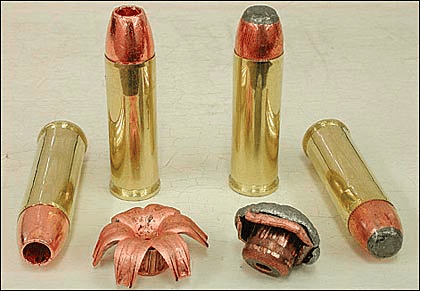
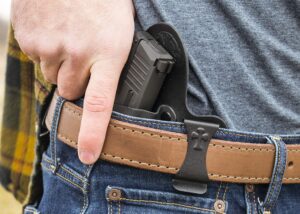
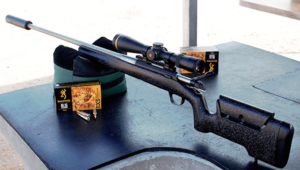
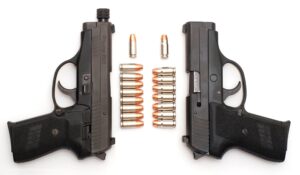
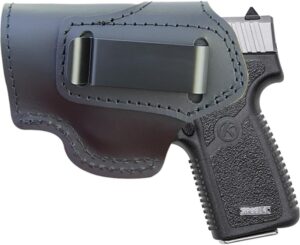
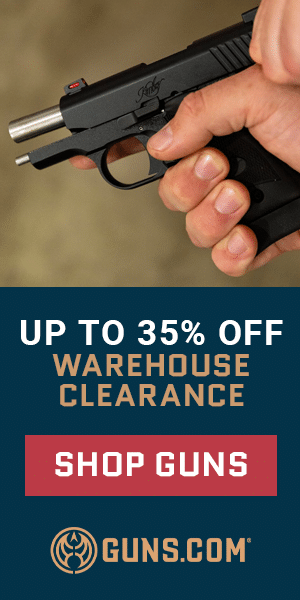


6 Responses
Great review. One of the better I’ve read on the subject.
My question is the chamber pressure. The .40 cal has a lot more chamber pressure (that explains the more recoil factor). Wouldn’t that mean more stopping power on impact? 180 grain .40 would have more energy than a 180 g .45.
No you are deadly wrong!!! 45 ACP with 185gr bullet has 1000fps, and 40S&W with 180gr bullet has 985fps. Moreover a .45ACP+P with 185gr bullet achieves 1130fps!!! A lot more!
“Because the underperformance of double action revolvers such as the .303 British…”
When was the .303 British a handgun round?
I’m afraid this article was lacking on a key component. Most 45 rounds travel in the 800-900 ft/sec range. Most 40 cal travel 200-400 ft/sec faster. Most ammo boxes list their avg velocity and foot pounds of energy. Avg ft/lbs on a 45 is @360-390ft/lbs. Most 40 cal is 460-490 ft/lbs. as per physics, as the weight (mass) increases the energy increases mathematically. As the speed increases, the energy increases geometrically…(remember those little exponents in math class?). That’s why a 300’ meteor can take out a whole city. That said, they are both competent rounds for self defense. Pick the gun you like in either caliber. And practice – that is the best ‘safety’ measure.
this seems like a decidedly pro .45 blog of info.
the 45 has “less flip” because it is Heavier. no other reason unless its magic.
add a 2 oz light to the .40 problem solved. or port it)
.40cal 180-200Gr 1050=1100 fps = plenty of stopping power.
this should include the 10mm stats as well.